engine YAMAHA TMAX 2015 Service Manual
[x] Cancel search | Manufacturer: YAMAHA, Model Year: 2015, Model line: TMAX, Model: YAMAHA TMAX 2015Pages: 112, PDF Size: 6.38 MB
Page 96 of 112
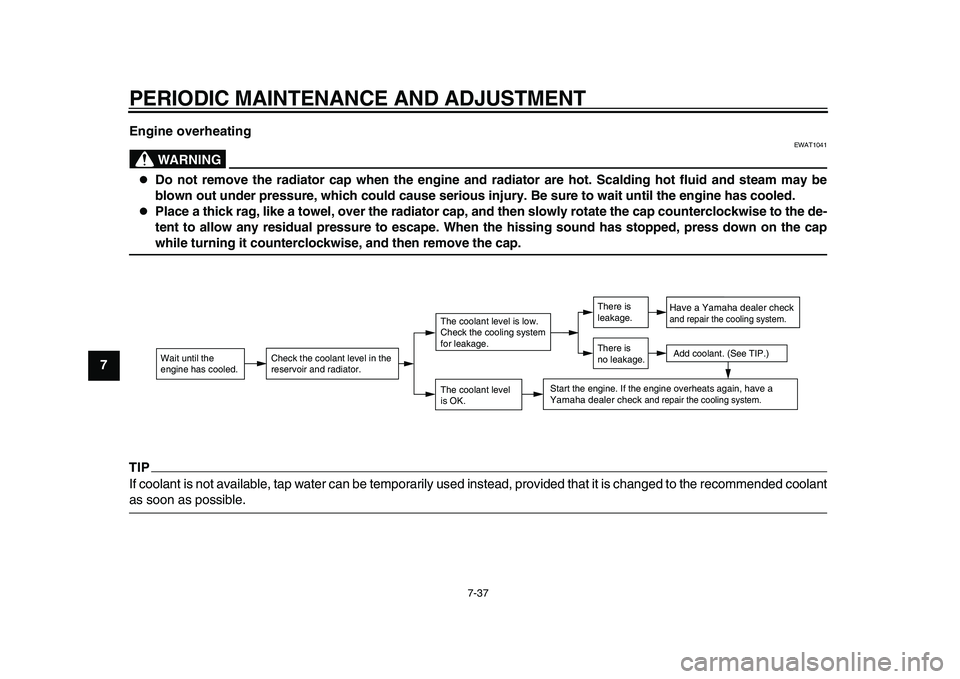
PERIODIC MAINTENANCE AND ADJUSTMENT
7-37
1
2
3
4
5
67
8
9
10
11
12 Engine overheating
WARNING
EWAT1041
Do not remove the radiator cap when the engine and radiator are hot. Scalding hot fluid and steam may be
blown out under pressure, which could cause serious injury. Be sure to wait until the engine has cooled.
Place a thick rag, like a towel, over the radiator cap, and then slowly rotate the cap counterclockwise to the de-
tent to allow any residual pressure to escape. When the hissing sound has stopped, press down on the capwhile turning it counterclockwise, and then remove the cap.
TIPIf coolant is not available, tap water can be temporarily us
ed instead, provided that it is changed to the recommended coolantas soon as possible.
Wait until the
engine has cooled.
Check the coolant level in the
reservoir and radiator.
The coolant level
is OK.The coolant level is low.
Check the cooling system
for leakage.
Have a Yamaha dealer checkand repair the cooling system.Add coolant. (See TIP.)
Start the engine. If the engine overheats again,
have a
Yamaha dealer check
and repair the cooling system.
There is
leakage.
There is
no leakage.
2PW-9-E0_1.book 37 ページ 2015年2月19日 木曜日 午後3時30分
Page 97 of 112
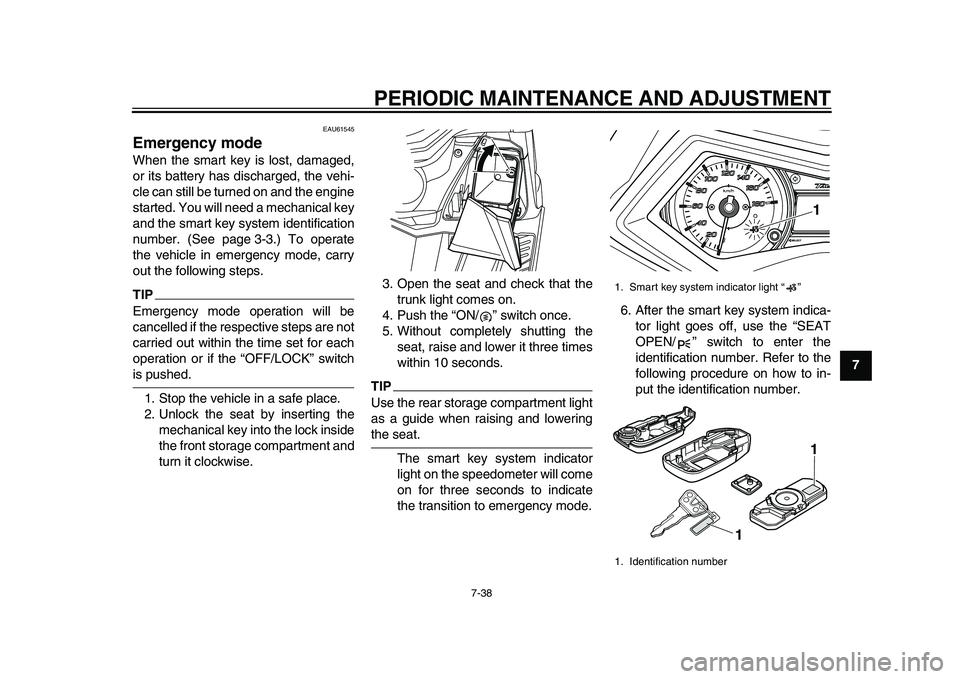
PERIODIC MAINTENANCE AND ADJUSTMENT
7-38
1
2
3
4
5
678
9
10
11
12
EAU61545
Emergency modeWhen the smart key is lost, damaged,
or its battery has discharged, the vehi-
cle can still be turned on and the engine
started. You will need a mechanical key
and the smart key system identification
number. (See page 3-3.) To operate
the vehicle in emergency mode, carry
out the following steps.TIPEmergency mode operation will be
cancelled if the respective steps are not
carried out within the time set for each
operation or if the “OFF/LOCK” switchis pushed. 1. Stop the vehicle in a safe place.
2. Unlock the seat by inserting the mechanical key into the lock inside
the front storage compartment and
turn it clockwise. 3. Open the seat and check that the
trunk light comes on.
4. Push the “ON/ ” switch once.
5. Without completely shutting the seat, raise and lower it three times
within 10 seconds.
TIPUse the rear storage compartment light
as a guide when raising and loweringthe seat.
The smart key system indicator
light on the speedometer will come
on for three seconds to indicate
the transition to emergency mode. 6. After the smart key system indica-
tor light goes off, use the “SEAT
OPEN/ ” switch to enter the
identification number. Refer to the
following procedure on how to in-
put the identification number.
1. Smart key system indicator light “ ”
1. Identification number
1
1 1
2PW-9-E0_1.book 38 ページ 2015年2月19日 木曜日 午後3時30分
Page 98 of 112
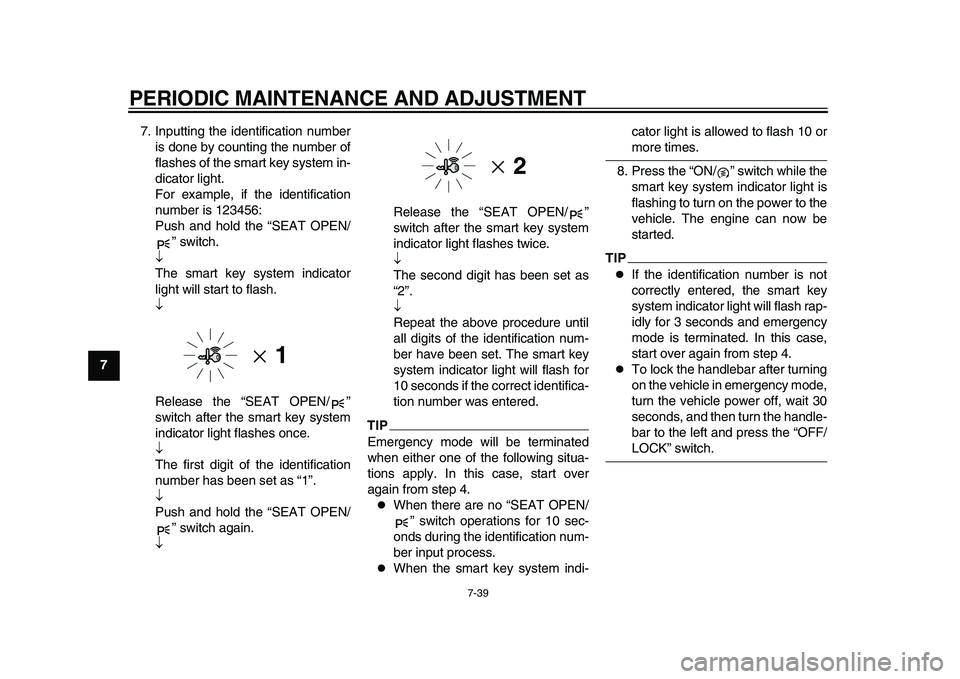
PERIODIC MAINTENANCE AND ADJUSTMENT
7-39
1
2
3
4
5
67
8
9
10
11
12 7. Inputting the identification number
is done by counting the number of
flashes of the smart key system in-
dicator light.
For example, if the identification
number is 123456:
Push and hold the “SEAT OPEN/ ” switch.
The smart key system indicator
light will start to flash.
Release the “SEAT OPEN/ ”
switch after the smart key system
indicator light flashes once.
The first digit of the identification
number has been set as “1”.
Push and hold the “SEAT OPEN/ ” switch again.
Release the “SEAT OPEN/ ”
switch after the smart key system
indicator light flashes twice.
The second digit has been set as
“2”.
Repeat the above procedure until
all digits of the
identification num-
ber have been set. The smart key
system indicator light will flash for
10 seconds if the correct identifica-
tion number was entered.
TIPEmergency mode will be terminated
when either one of the following situa-
tions apply. In this case, start over
again from step 4.
When there are no “SEAT OPEN/ ” switch operations for 10 sec-
onds during the identification num-
ber input process.
When the smart key system indi- cator light is allowed to flash 10 or
more times.
8. Press the “ON/ ” switch while the smart key system indicator light is
flashing to turn on the power to the
vehicle. The engine can now be
started.
TIP
If the identification number is not
correctly entered, the smart key
system indicator light will flash rap-
idly for 3 seconds and emergency
mode is terminated. In this case,
start over again from step 4.
To lock the handlebar after turning
on the vehicle in emergency mode,
turn the vehicle power off, wait 30
seconds, and then turn the handle-
bar to the left and press the “OFF/LOCK” switch.
2PW-9-E0_1.book 39 ページ 2015年2月19日 木曜日 午後3時30分
Page 99 of 112
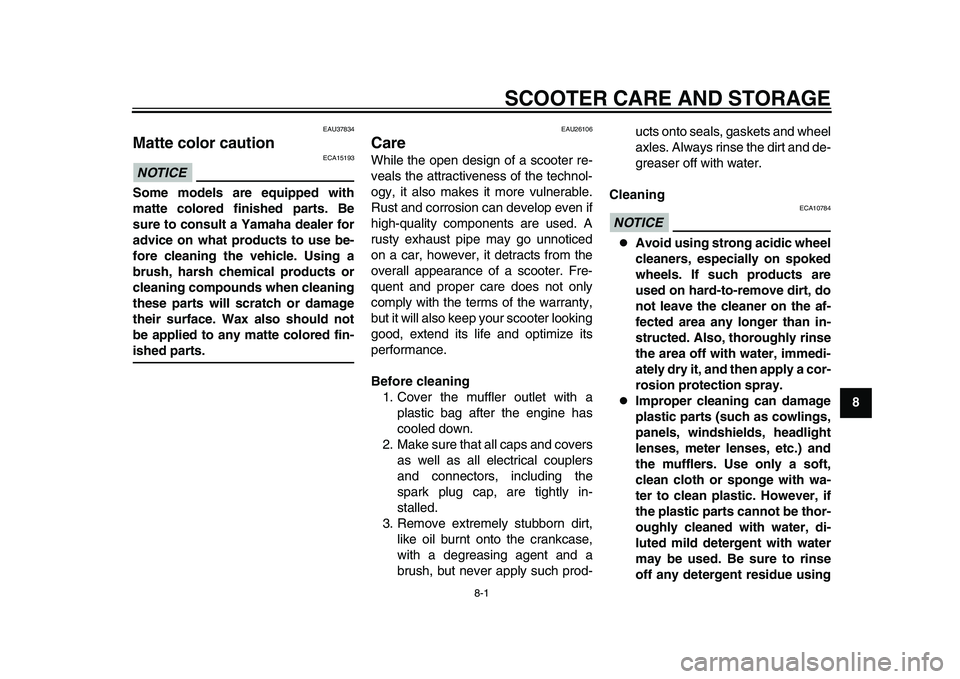
8-1
1
2
3
4
5
6
789
10
11
12
SCOOTER CARE AND STORAGE
EAU37834
Matte color cautionNOTICE
ECA15193
Some models are equipped with
matte colored finished parts. Be
sure to consult a Yamaha dealer for
advice on what products to use be-
fore cleaning the vehicle. Using a
brush, harsh chemical products or
cleaning compounds when cleaning
these parts will scratch or damage
their surface. Wax also should not
be applied to any matte colored fin-ished parts.
EAU26106
CareWhile the open design of a scooter re-
veals the attractiveness of the technol-
ogy, it also makes it more vulnerable.
Rust and corrosion can develop even if
high-quality components are used. A
rusty exhaust pipe may go unnoticed
on a car, however, it detracts from the
overall appearance of a scooter. Fre-
quent and proper care does not only
comply with the terms of the warranty,
but it will also keep your scooter looking
good, extend its life and optimize its
performance.
Before cleaning 1. Cover the muffler outlet with a plastic bag after the engine has
cooled down.
2. Make sure that all caps and covers as well as all el ectrical couplers
and connectors, including the
spark plug cap, are tightly in-
stalled.
3. Remove extremely stubborn dirt, like oil burnt onto the crankcase,
with a degreasing agent and a
brush, but never apply such prod- ucts onto seals, gaskets and wheel
axles. Always rinse the dirt and de-
greaser off with water.
Cleaning
NOTICE
ECA10784
Avoid using strong acidic wheel
cleaners, especially on spoked
wheels. If such products are
used on hard-to-remove dirt, do
not leave the cleaner on the af-
fected area any longer than in-
structed. Also, thoroughly rinse
the area off with water, immedi-
ately dry it, and then apply a cor-
rosion protection spray.
Improper cleaning can damage
plastic parts (such as cowlings,
panels, windshields, headlight
lenses, meter lenses, etc.) and
the mufflers. Use only a soft,
clean cloth or sponge with wa-
ter to clean plastic. However, if
the plastic parts cannot be thor-
oughly cleaned with water, di-
luted mild detergent with water
may be used. Be sure to rinse
off any detergent residue using
2PW-9-E0_1.book 1 ページ 2015年2月19日 木曜日 午後3時30分
Page 102 of 112
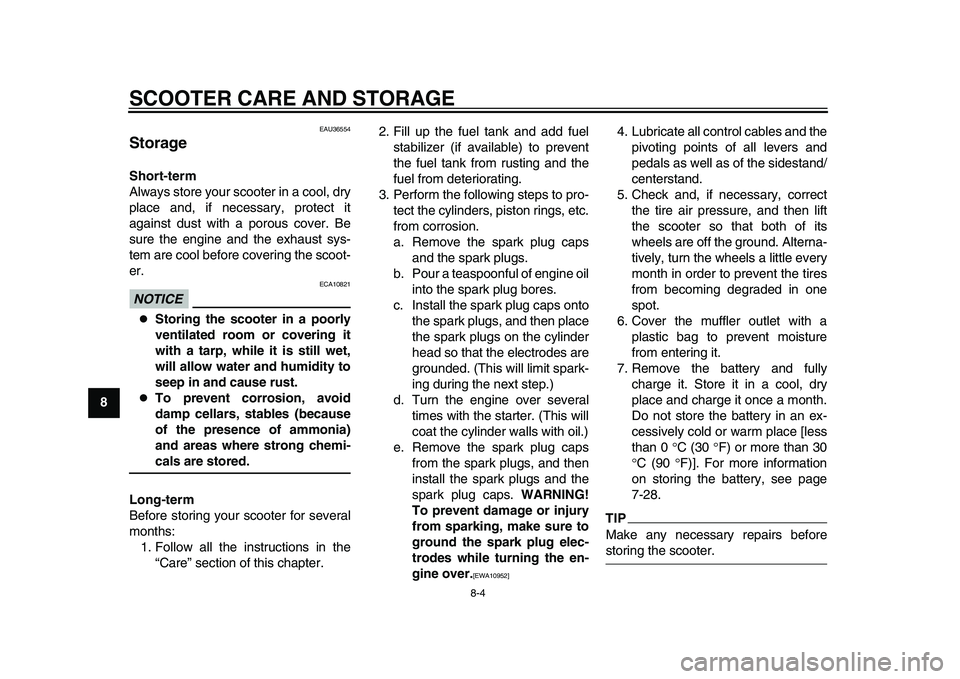
SCOOTER CARE AND STORAGE
8-4
1
2
3
4
5
6
78
9
10
11
12
EAU36554
StorageShort-term
Always store your scooter in a cool, dry
place and, if necessary, protect it
against dust with a porous cover. Be
sure the engine and the exhaust sys-
tem are cool before covering the scoot-
er.NOTICE
ECA10821
Storing the scooter in a poorly
ventilated room or covering it
with a tarp, while it is still wet,
will allow water and humidity to
seep in and cause rust.
To prevent corrosion, avoid
damp cellars, stables (because
of the presence of ammonia)
and areas where strong chemi-cals are stored.
Long-term
Before storing your scooter for several
months: 1. Follow all the instructions in the “Care” section of this chapter. 2. Fill up the fuel tank and add fuel
stabilizer (if available) to prevent
the fuel tank from rusting and the
fuel from deteriorating.
3. Perform the following steps to pro- tect the cylinders, piston rings, etc.
from corrosion.
a. Remove the spark plug caps and the spark plugs.
b. Pour a teaspoonful of engine oil into the spark plug bores.
c. Install the spark plug caps onto the spark plugs, and then place
the spark plugs on the cylinder
head so that the electrodes are
grounded. (This will limit spark-
ing during the next step.)
d. Turn the engine over several times with the starter. (This will
coat the cylinder walls with oil.)
e. Remove the spark plug caps from the spark plugs, and then
install the spark plugs and the
spark plug caps. WARNING!
To prevent damage or injury
from sparking, make sure to
ground the spark plug elec-
trodes while turning the en-
gine over.
[EWA10952]
4. Lubricate all control cables and the pivoting points of all levers and
pedals as well as of the sidestand/
centerstand.
5. Check and, if necessary, correct the tire air pressure, and then lift
the scooter so that both of its
wheels are off the ground. Alterna-
tively, turn the wheels a little every
month in order to prevent the tires
from becoming degraded in one
spot.
6. Cover the muffler outlet with a plastic bag to prevent moisture
from entering it.
7. Remove the battery and fully charge it. Store it in a cool, dry
place and charge it once a month.
Do not store the battery in an ex-
cessively cold or warm place [less
than 0 C (30 F) or more than 30
C (90 F)]. For more information
on storing the battery, see page
7-28.TIPMake any necessary repairs beforestoring the scooter.
2PW-9-E0_1.book 4 ページ 2015年2月19日 木曜日 午後3時30分
Page 103 of 112
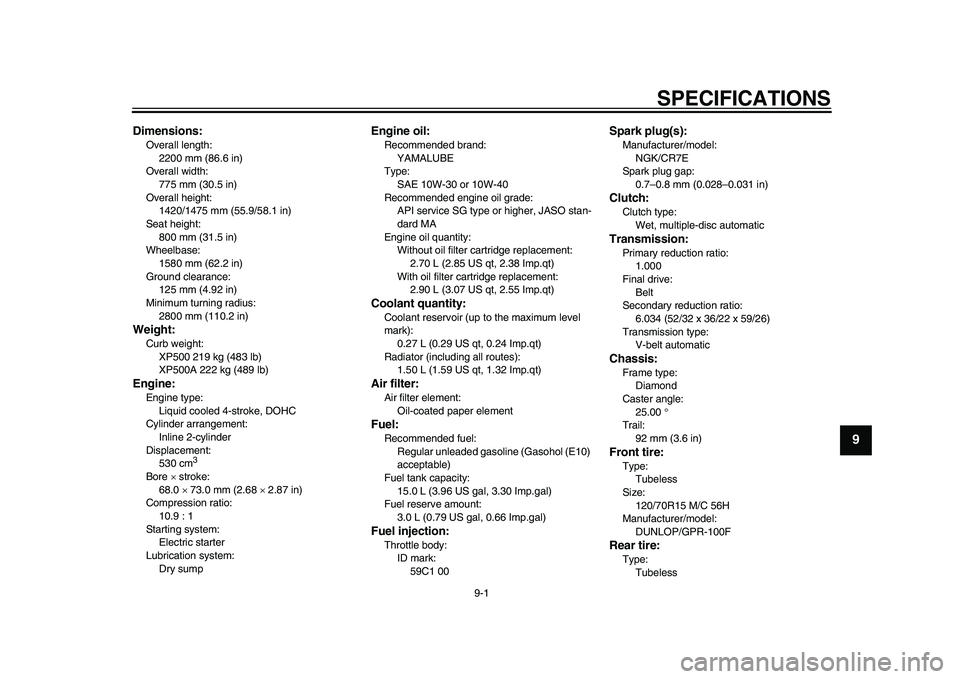
9-1
1
2
3
4
5
6
7
8910
11
12
SPECIFICATIONS
EAU5091R
Dimensions:Overall length:2200 mm (86.6 in)
Overall width: 775 mm (30.5 in)
Overall height: 1420/1475 mm (55.9/58.1 in)
Seat height:
800 mm (31.5 in)
Wheelbase: 1580 mm (62.2 in)
Ground clearance: 125 mm (4.92 in)
Minimum turning radius:
2800 mm (110.2 in)Weight:Curb weight:XP500 219 kg (483 lb)
XP500A 222 kg (489 lb)Engine:Engine type:Liquid cooled 4-stroke, DOHC
Cylinder arrangement: Inline 2-cylinder
Displacement: 530 cm
3
Bore stroke:
68.0 73.0 mm (2.68 2.87 in)
Compression ratio: 10.9 : 1
Starting system: Electric starter
Lubrication system:
Dry sump
Engine oil:Recommended brand:YAMALUBE
Type: SAE 10W-30 or 10W-40
Recommended engine oil grade: API service SG type or higher, JASO stan-
dard MA
Engine oil quantity: Without oil filter ca rtridge replacement:
2.70 L (2.85 US qt, 2.38 Imp.qt)
With oil filter cartridge replacement: 2.90 L (3.07 US qt, 2.55 Imp.qt)Coolant quantity:Coolant reservoir (up to the maximum level
mark):
0.27 L (0.29 US qt, 0.24 Imp.qt)
Radiator (including all routes): 1.50 L (1.59 US qt, 1.32 Imp.qt)Air filter:Air filter element:
Oil-coated paper elementFuel:Recommended fuel:Regular unleaded gasoli ne (Gasohol (E10)
acceptable)
Fuel tank capacity: 15.0 L (3.96 US gal, 3.30 Imp.gal)
Fuel reserve amount:
3.0 L (0.79 US gal, 0.66 Imp.gal)Fuel injection:Throttle body:ID mark:59C1 00
Spark plug(s):Manufacturer/model:
NGK/CR7E
Spark plug gap: 0.7–0.8 mm (0.028–0.031 in)Clutch:Clutch type:
Wet, multiple-disc automaticTransmission:Primary reduction ratio:1.000
Final drive:
Belt
Secondary reduction ratio: 6.034 (52/32 x 36/22 x 59/26)
Transmission type: V-belt automaticChassis:Frame type:Diamond
Caster angle: 25.00
Trail:
92 mm (3.6 in)Front tire:Type:Tubeless
Size:
120/70R15 M/C 56H
Manufacturer/model: DUNLOP/GPR-100FRear tire:Type:
Tubeless
2PW-9-E0_1.book 1 ページ 2015年2月19日 木曜日 午後3時30分
Page 104 of 112
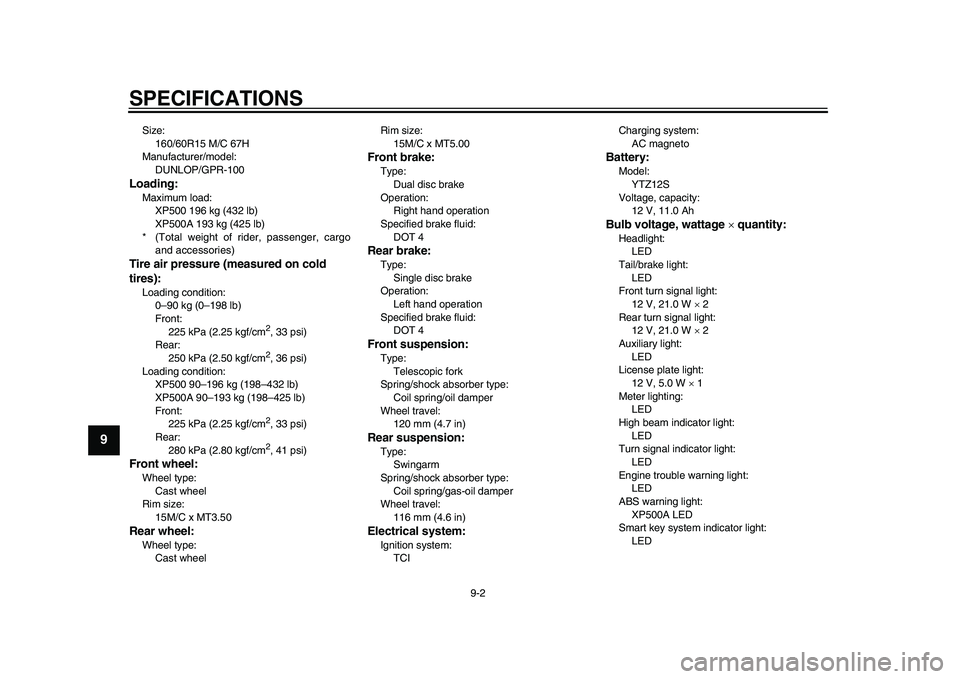
SPECIFICATIONS
9-2
1
2
3
4
5
6
7
89
10
11
12
Size: 160/60R15 M/C 67H
Manufacturer/model:
DUNLOP/GPR-100Loading:Maximum load:XP500 196 kg (432 lb)
XP500A 193 kg (425 lb)
* (Total weight of rider, passenger, cargo and accessories)Tire air pressure (measured on cold
tires):Loading condition:0–90 kg (0–198 lb)
Front:225 kPa (2.25 kgf/cm
2, 33 psi)
Rear: 250 kPa (2.50 kgf/cm2, 36 psi)
Loading condition: XP500 90–196 kg (198–432 lb)
XP500A 90–193 kg (198–425 lb)
Front:225 kPa (2.25 kgf/cm2, 33 psi)
Rear:
280 kPa (2.80 kgf/cm2, 41 psi)
Front wheel:Wheel type: Cast wheel
Rim size:
15M/C x MT3.50Rear wheel:Wheel type:Cast wheel Rim size:
15M/C x MT5.00
Front brake:Type:Dual disc brake
Operation: Right hand operation
Specified brake fluid:
DOT 4Rear brake:Type:Single disc brake
Operation:
Left hand operation
Specified brake fluid: DOT 4Front suspension:Type:
Telescopic fork
Spring/shock absorber type: Coil spring/oil damper
Wheel travel: 120 mm (4.7 in)Rear suspension:Type:Swingarm
Spring/shock absorber type: Coil spring/gas-oil damper
Wheel travel:
116 mm (4.6 in)Electrical system:Ignition system:TCI Charging system:
AC magneto
Battery:Model:YTZ12S
Voltage, capacity: 12 V, 11.0 AhBulb voltage, wattage quantity:Headlight:
LED
Tail/brake light: LED
Front turn signal light:
12 V, 21.0 W 2
Rear turn signal light: 12 V, 21.0 W 2
Auxiliary light: LED
License plate light:
12 V, 5.0 W 1
Meter lighting: LED
High beam indicator light: LED
Turn signal indicator light:
LED
Engine trouble warning light: LED
ABS warning light: XP500A LED
Smart key system indicator light:
LED
2PW-9-E0_1.book 2 ページ 2015年2月19日 木曜日 午後3時30分
Page 106 of 112
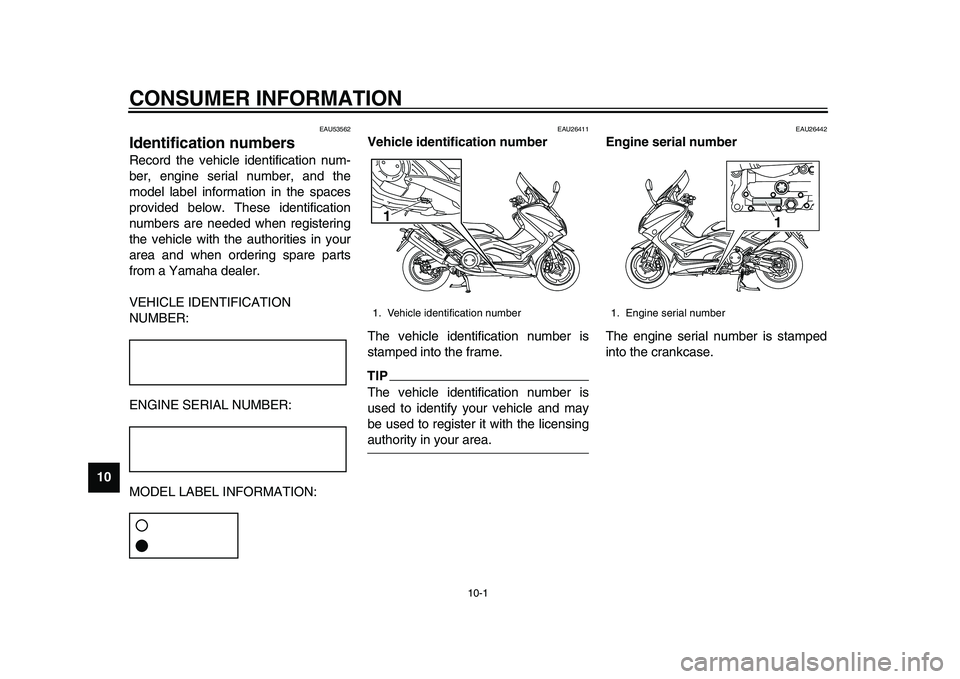
10-1
1
2
3
4
5
6
7
8
910
11
12
CONSUMER INFORMATION
EAU53562
Identification numbersRecord the vehicle identification num-
ber, engine serial number, and the
model label information in the spaces
provided below. These identification
numbers are needed when registering
the vehicle with the authorities in your
area and when ordering spare parts
from a Yamaha dealer.
VEHICLE IDENTIFICATION
NUMBER:
ENGINE SERIAL NUMBER:
MODEL LABEL INFORMATION:
EAU26411
Vehicle identification number
The vehicle identification number is
stamped into the frame.TIPThe vehicle identification number is
used to identify your vehicle and may
be used to register it with the licensingauthority in your area.
EAU26442
Engine serial number
The engine serial number is stamped
into the crankcase.
1. Vehicle identification number1
1. Engine serial number
1
2PW-9-E0_1.book 1 ページ 2015年2月19日 木曜日 午後3時30分
Page 108 of 112
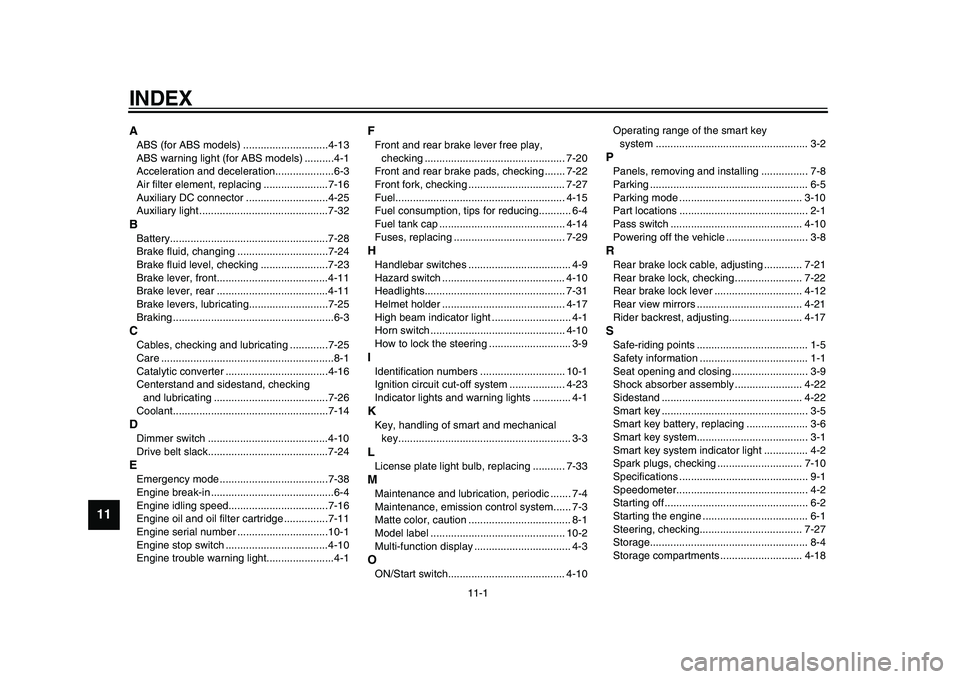
11-1
1
2
3
4
5
6
7
8
9
1011
12
INDEXAABS (for ABS models) .............................4-13
ABS warning light (for ABS models) ..........4-1
Acceleration and deceleration....................6-3
Air filter element, replacing ......................7-16
Auxiliary DC connector ............................4-25
Auxiliary light ............................................7-32BBattery......................................................7-28
Brake fluid, changing ...............................7-24
Brake fluid level, checking .......................7-23
Brake lever, front......................................4-11
Brake lever, rear ......................................4-11
Brake levers, lubricating...........................7-25
Braking .......................................................6-3CCables, checking and lubricating .............7-25
Care ...........................................................8-1
Catalytic converter ...................................4-16
Centerstand and sidestand, checking and lubricating .......................................7-26
Coolant.....................................................7-14DDimmer switch .........................................4-10
Drive belt slack.........................................7-24EEmergency mode .....................................7-38
Engine break-in ..........................................6-4
Engine idling speed..................................7-16
Engine oil and oil filter cartridge ...............7-11
Engine serial number ...............................10-1
Engine stop switch ...................................4-10
Engine trouble warning light.......................4-1
FFront and rear brak e lever free play,
checking ................................................ 7-20
Front and rear brake pads, checking ....... 7-22
Front fork, checking ................................. 7-27
Fuel.......................................................... 4-15
Fuel consumption, tips for reducing........... 6-4
Fuel tank cap ........................................... 4-14
Fuses, replacing ...................................... 7-29HHandlebar switches ................................... 4-9
Hazard switch .......................................... 4-10
Headlights................................................ 7-31
Helmet holder .......................................... 4-17
High beam indicator light ........................... 4-1
Horn switch .............................................. 4-10
How to lock the steering ............................ 3-9IIdentification numbers ............................. 10-1
Ignition circuit cut-off system ................... 4-23
Indicator lights and warning lights ............. 4-1KKey, handling of smart and mechanical
key........................................................... 3-3LLicense plate light bulb, replacing ........... 7-33MMaintenance and lubrication, periodic ....... 7-4
Maintenance, emission control system...... 7-3
Matte color, caution ................................... 8-1
Model label .............................................. 10-2
Multi-function display ................................. 4-3OON/Start switch........................................ 4-10 Operating range of the smart key
system .................................................... 3-2
PPanels, removing and installing ................ 7-8
Parking ...................................................... 6-5
Parking mode .......................................... 3-10
Part locations ............................................ 2-1
Pass switch ............................................. 4-10
Powering off the vehicle ............................ 3-8RRear brake lock cable, adjusting ............. 7-21
Rear brake lock, checking ....................... 7-22
Rear brake lock lever .............................. 4-12
Rear view mirrors .................................... 4-21
Rider backrest, adjusting......................... 4-17SSafe-riding points ...................................... 1-5
Safety information ..................................... 1-1
Seat opening and closing .......................... 3-9
Shock absorber assembly ....................... 4-22
Sidestand ................................................ 4-22
Smart key .................................................. 3-5
Smart key battery, replacing ..................... 3-6
Smart key system...................................... 3-1
Smart key system indicator light ............... 4-2
Spark plugs, checking ............................. 7-10
Specifications ............................................ 9-1
Speedometer............................................. 4-2
Starting off ................................................. 6-2
Starting the engine .................................... 6-1
Steering, checking................................... 7-27
Storage...................................................... 8-4
Storage compartments ............................ 4-18
2PW-9-E0_1.book 1 ページ 2015年2月19日 木曜日 午後3時30分